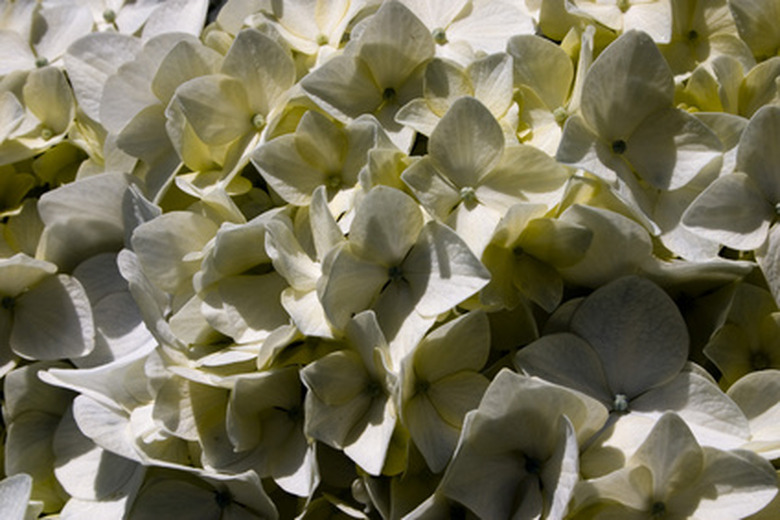The Root System Of A Climbing Hydrangea
Climbing hydrangeas have many benefits for home landscaping, particularly in creating screening and year-round interest on a wall, fence or large tree. Although slow in growth until it becomes established, a climbing hydrangea can reach 60 feet. Lush green foliage appears in the spring with large white flower heads beginning to bloom by midsummer, lasting for several weeks as the blossoms slowly turn to pink. In the fall the foliage yellows and drops, leaving an interesting web of reddish brown vine where it grows.
Type
Unlike vines that attach to supports using long twining tendrils, the climbing hydrangea vine, Hydrangea paniculata, uses strong aerial rootlets to attach the vine to surfaces. The long aerial rootlets have disklike ends that secrete a cementlike substance that help the strong tendrils adhere to surfaces.
Function
Climbing hydrangea aerial rootlets are strong and able to easily support the heavy vines as the plant grows up to 60 feet. Because the rootlets can attach to flat or odd-shaped surfaces, a climbing hydrangea is often used in landscapes to cover a wall, fence or a large tree. Despite the rootlets' cementlike secretion, if grown where the rootlets cannot invade crevices, the roots will not harm most surfaces, which is why climbing hydrangeas are often used to cover masonry type walls and rock or brick fences.
- Climbing hydrangeas have many benefits for home landscaping, particularly in creating screening and year-round interest on a wall, fence or large tree.
- Despite the rootlets' cementlike secretion, if grown where the rootlets cannot invade crevices, the roots will not harm most surfaces, which is why climbing hydrangeas are often used to cover masonry type walls and rock or brick fences.
Benefits
Climbing hydrangeas are slow to start, but once established they can grow rapidly. The aerial rootlets, because of their strength and stability, allow the climber to quickly cover an area. Climbing hydrangeas thrive in shaded, moist environments, and with the versatile rootlets, they are ideal for growing on the bark of large trees, shaded walls and fencing.
Effects
The effects of the rootlets of a climbing hydrangea can be controlled, somewhat, by the gardener. Using rose nails, soft-headed nail heads, that can easily be driven into masonry, you can direct and train the growth direction of the vine and the rootlets. Left to grow on its own, the vine has an open appearance with a striking textural look of reddish vine branches artistically attached by rootlets to surfaces during the winter.
Considerations
Although climbing hydrangea rootlets will not harm masonry surfaces, the vine and rootlets do retain moisture, and the rootlets keep the vine close to the surface it is attached to. Therefore, the aerial rootlets can cause rot and decay on wood surfaces. Erecting a climbing trestle a few inches away from the wood surface for the aerial rootlets to attach to will solve the problem. Once the aerial rootlets are established on a surface, it is extremely difficult to remove, or reposition, the living vine. The location you select to grow a climbing hydrangea should be permanent.
- Climbing hydrangeas are slow to start, but once established they can grow rapidly.
- Although climbing hydrangea rootlets will not harm masonry surfaces, the vine and rootlets do retain moisture, and the rootlets keep the vine close to the surface it is attached to.
